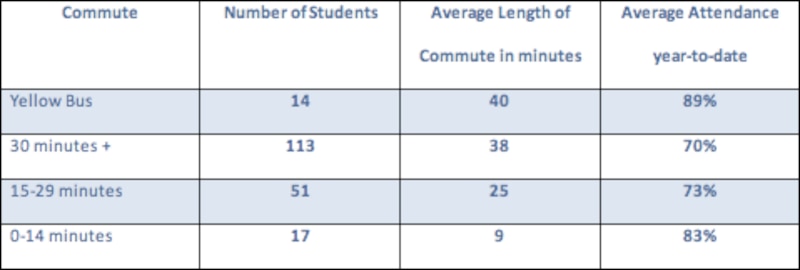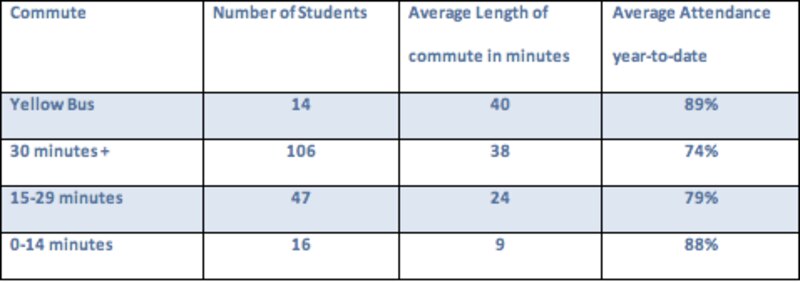With funding for student Metrocards on the line, students’ commutes have been a hot topic lately. But is it good for students to be commuting long distances?
I do not doubt that a great many students across the city travel long distances to attend a school they feel are the best fit for their needs. But students don’t always take on long commutes out of choice. Suspecting that lengthy commutes actually hurt many of our most vulnerable students, I undertook a study into attendance statistics that suggests that it might be better for some students to have a shorter trip to school.
The Background
We already know that enrollment patterns have an impact on progress report grades and contribute to the low scores received by schools that have been slated to close. Three years ago, I noticed a relationship between self-contained special education students (high-needs students requiring smaller classes) and progress report grades: Schools receiving poor grades serve far higher percentages of self-contained students.
In the last few months, I have looked deeper into these patterns within the Bronx, trying to understand the increasingly high concentrations of self-contained special needs students within the remaining large high schools (see the details by district here). I hypothesized that this ongoing shift was also not good for the students, who were being assigned to travel increasingly far to get to school as their neighborhood schools closed. I sought research on the relationship between commute and achievement for these most vulnerable of students, but kept coming up empty. All I could find were anecdotal references.
The Process
I developed a simple research project that began by sorting the addresses of our high-needs (self-contained) special needs students by zip code. The first thing I did was use the DOE’s “find a school” search engine and input the zip codes and asked for a ninth-grade school. I found that 75 of Columbus High School’s 198 self-contained students actually live in the zip codes of the educational campuses that have replaced large high schools that have been closed. Only four live inside zip codes of existing zoned high schools (there are only four left in the Bronx – Columbus, JFK, Lehman and Truman), while 22 live in the zip code for Columbus. But what also struck me was that so many children are traveling so far to get to school.
I checked individual student commutes using hopstop.com, using a Monday morning 7 a.m. time, using either subway or bus, and choosing walking over more transfers. It was immediately obvious that many students were traveling extended distances and times. I then used ARIS, the city’s school data system, to check year-to-date attendance records (from September). Very quickly I noticed a strong correlation. A quick check of the first 13 students I picked up traveling more than 45 minutes to school against the students in the Columbus zip code yielded a massive difference. Those in the Columbus zip code averaged 87.6 percent attendance, while those traveling 45 minutes or further attended school only 67.6 percent of the time.
This finding motivated me to invest several more hours over the February break collecting the additional data needed to give a complete picture of our high-needs students and the relationship between their commutes and their attendance. It was necessary to omit four students who did not have adequate data available.
Results
My findings confirmed my hypothesis — that students attend school less often when their commutes are long — although I learned a few practical realities along the way.
First, zip code is not the most reliable indicator of proximity to a school. Students who live in a zip code that the search engine pointed to the Evander campus schools as the closest option were actually living two blocks away from Columbus, while some students in the Columbus zip code actually had to travel more than 20 minutes to get to school. So I decided to break the students down into three commuting zones — 0-14 minutes, 15-29 minutes, 30+ minutes — and I considered the students traveling on the yellow bus separately as a fourth group.
The following chart shows the relationship between the attendance rates of Columbus’s self-contained special education students and the lengths of their commutes:

One of the reasons that the percentages are so low is that 12 students had extremely low attendance rates — below 10 percent. I looked into the reason for these long-term absences and found that two of the 12 students have been dealing with homelessness; two were dealing with medical/psychological issues; and one had just been placed in the school on Feb. 2 but had not yet shown up at Columbus even once. The remaining seven students have received calls, letters and have been visited at home by attendance and Administration for Children’s Services workers to no avail. I decided it was fair to remove this set of students from the larger group because it was clear that their lack of attendance was not related to their commute time.
After I removed this group of students and recalculated the numbers, these were the results:

Again I found that students attend school more often the shorter their commute is. Students who take yellow buses to school have the most reliable attendance.
Limitations and Further Study
I make no great claims here: My study is admittedly small and conducted at a single point in time. I hope that someone in a position better situated to undertake a more substantial study will do so and further investigate the relationship between attendance and commute time further.
I plan to follow up by looking at the relationship between commute length and credit accumulation. I’d also like to see the impact of commute on other high-need populations of students. Could it be that many students would actually benefit from having neighborhood schools to attend?
About our First Person series:
First Person is where Chalkbeat features personal essays by educators, students, parents, and others trying to improve public education. Read our submission guidelines here.
